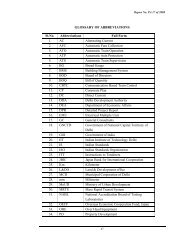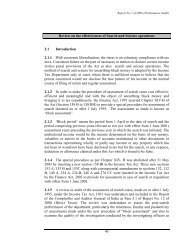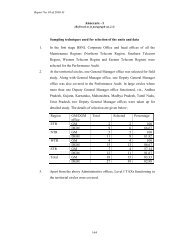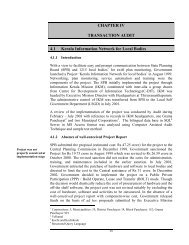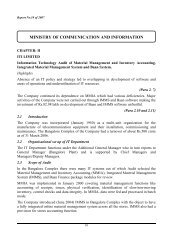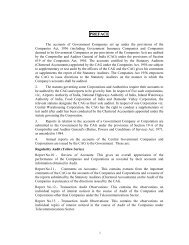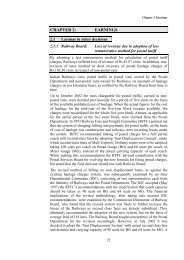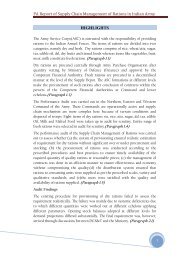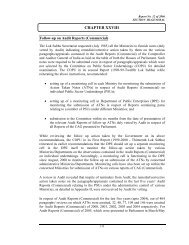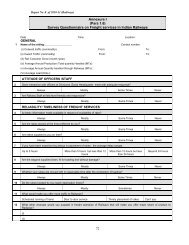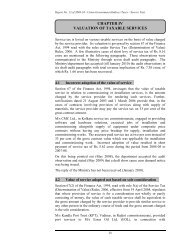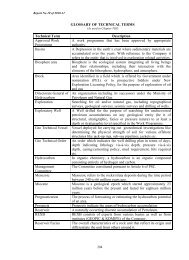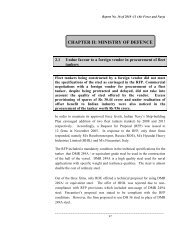Chapter 1 Freight services in Indian Railways - Comptroller and ...
Chapter 1 Freight services in Indian Railways - Comptroller and ...
Chapter 1 Freight services in Indian Railways - Comptroller and ...
Create successful ePaper yourself
Turn your PDF publications into a flip-book with our unique Google optimized e-Paper software.
<strong>Chapter</strong> 1 <strong>Freight</strong> Services <strong>in</strong> <strong>Indian</strong> <strong>Railways</strong><br />
electric <strong>and</strong> diesel locomotives. IR further mentioned that keep<strong>in</strong>g <strong>in</strong> view the<br />
budgetary requirement for various projects the locomotive plants were aga<strong>in</strong><br />
proposed to be taken up as jo<strong>in</strong>t venture projects. This highlighted that the<br />
plann<strong>in</strong>g process was flawed as the fund<strong>in</strong>g mechanism was not firmed up<br />
before obta<strong>in</strong><strong>in</strong>g Cab<strong>in</strong>et approval for sett<strong>in</strong>g up of these plants as railways’<br />
own production units.<br />
L<strong>in</strong>kage with zonal power plans<br />
The annual Roll<strong>in</strong>g Stock Programmes had no l<strong>in</strong>kage to the zonal power<br />
plans <strong>and</strong> was, therefore, not synchronised with requirements affect<strong>in</strong>g the<br />
availability of locomotives vis-à-vis requirements <strong>in</strong> the zones. Shortage of<br />
electric locomotives was observed <strong>in</strong> five (SER, ECoR, SECR, ER <strong>and</strong> ECR)<br />
out of the eleven zones, which had electric traction (data was not available <strong>in</strong><br />
two zones- WR <strong>and</strong> WCR); two zones (SCR <strong>and</strong> NCR) had assessed that<br />
locomotives were surplus to its requirement, while locomotives were<br />
commensurate with requirements <strong>in</strong> the other four zones (SR, NR, CR <strong>and</strong><br />
SWR). Similarly, shortage of diesel locomotives was observed <strong>in</strong> three zones<br />
(SECR, NER <strong>and</strong> ECR) while <strong>in</strong> three zones (SER, NWR <strong>and</strong> SCR) the<br />
locomotives were <strong>in</strong> excess of requirements.<br />
Ow<strong>in</strong>g to shortage of electric locomotives, zones were deploy<strong>in</strong>g diesel<br />
locomotives on electrified traction. In SER, which had 85 per cent of its route<br />
kilometers on electrified traction, the excess hold<strong>in</strong>g of diesel locomotives<br />
ranged from 126 (<strong>in</strong> 2006-07) to 152 (<strong>in</strong> 2004-05) locomotives dur<strong>in</strong>g the<br />
period from 2004-05 to 2008-09 under review. Apart from lend<strong>in</strong>g diesel<br />
locomotives to two contiguous zones, SER was deploy<strong>in</strong>g diesel locomotives,<br />
which had a comparatively higher cost of operation, on routes with electrified<br />
traction. To have a perspective of the cost implication, deployment of diesel<br />
locomotives <strong>in</strong> 12 electrified sections, <strong>in</strong> SER, dur<strong>in</strong>g the period 2004-05 to<br />
2008-09 resulted <strong>in</strong> an additional expenditure of Rs.435.71 crore on fuel<br />
consumption alone. The zone stated that mov<strong>in</strong>g freight was the ma<strong>in</strong><br />
objective <strong>and</strong> both diesel <strong>and</strong> electric locomotives had to be used to manage<br />
the growth of traffic. The fact, however, rema<strong>in</strong>ed that due to shortage of<br />
electric locomotives, the zone carried traffic by deploy<strong>in</strong>g diesel locomotives,<br />
which had a higher cost of operation.<br />
Further, <strong>in</strong> SCR even with <strong>in</strong>troduction of improvised versions of diesel<br />
locomotives hav<strong>in</strong>g lesser ma<strong>in</strong>tenance schedules, the zone while assess<strong>in</strong>g its<br />
requirements of locomotives cont<strong>in</strong>ued to provide a cushion of 10 per cent<br />
towards unforeseen repairs, while analysis revealed that locomotives receiv<strong>in</strong>g<br />
unforeseen repairs never exceeded seven <strong>and</strong> a half per cent.<br />
IR <strong>in</strong> its reply (March 2010) mentioned that growth of traffic <strong>in</strong> most of the<br />
zones fac<strong>in</strong>g shortage of locomotives was above the IR’s average growth <strong>and</strong><br />
accepted that the <strong>in</strong>creased overall growth <strong>in</strong> freight load<strong>in</strong>g resulted <strong>in</strong><br />
<strong>in</strong>creased requirement of locomotives. As such the Roll<strong>in</strong>g Stock Programmes<br />
of locomotives could not match the bare requirement of locomotives for<br />
efficient movement of freight traffic. IR also stated that diesel locomotives<br />
were deployed <strong>in</strong> electrified territories due to operational requirements (i.e. the<br />
locomotives were required to move from one non-electrified territory to<br />
9



